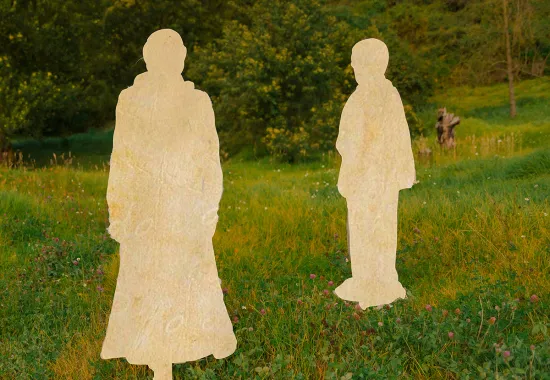The Sonnet and Startling Syntax
Terrance Hayes’ panic closet. Edward Baugh’s boxing ring. Wordsworth’s hermit cell. Too many birdcages to count. We tend to conceive of the sonnet form as a container, and its boxed-in look and feel may contribute its sometimes being considered oppressive. How do some stunningly good—rebelliously good—poets find in it, then, a freedom, a permission “to go in [their] own direction”? I’d like to suggest, as a creative practice, thinking about the sonnet less as a confined space and more as a tool, something we can use—especially to startle syntax and to expand our vocal range. In the following paragraphs, I’ll consider the former.
When we start out to make a case for something in roughly 140 syllables, we put immediate pressure on syntax, a pressure that can pop our sentence patterns off a habitual, unconscious track. Far from iambic plod or empty rhetoric, here is what alert syntax sounds like:
I caught this morning morning’s minion, king-
dom of daylight’s dauphin, dapple-dawn-drawn Falcon,
in his riding
Of the rolling level underneath him steady air...
—Gerard Manley Hopkins, “The Windhover”
First fight. Then fiddle. Ply the slipping string
With feathery sorcery; muzzle the note
With hurting love; the music that they wrote
Bewitch, bewilder. Qualify to sing
Threadwise....
—Gwendolyn Brooks, “First Fight. Then Fiddle”
Supposing we could just go on and on as two
voracious in the days apart as well as when
we side by side (the many ways we do
that) well! I would consider then
perfection possible...
—June Jordan, “Sunflower Sonnet Number Two”
Not in made perfection, but in the playfulness of making, lies the sonnet’s greatest value to us as poets. Tapped by the demand to construct—quickly!—a comprehensible argument, our linear thinking (i.e., our critical voice) is distracted; our creative MVP is benched. Intuition enters the game. Surprises ensue. We are carried forward by words we didn’t know we knew to use until they’re there, doing double duty, keeping the line moving, the poem turning.
1) the lumpenproletariat 2) slipshod
and swearing 3) able to attain escape
velocity 4) a cruddy, shoddy cod-
piece 5) a Neanderthal above the nape
6) a pig’s exquisitely sensitive nose
7) penned in forever 8) the roughest measure
of our carnal instincts 9) the meat that froze
10) a nocturnal grunt who sniffs out treasure...
—Marty Steyer, “Caliban Is Not”
...Like cherubim—
The office staff, accountants, businessmen—
Within the ash of morning, they would glisten,
Remembering that love’s a crucible,
And wishing—as did we—for a hand (something!)
To tap the heavens, see if God’s at home.
And fell. Such quiet in their terror-song.
—Kim Bridgford, “Jumping”
We can use the sonnet to wedge or play or sound our way into a poem, and the delightful paradox is that this form can accommodate so much. In the same way a player on a scoring streak perceives the hoop getting wider and wider with each made shot, falling into the sonnet zone feels like a sudden opening, a capaciousness. I suspect this is why, when individual syllables are at a premium, powerful sonnets fearlessly repeat their diction to the point of incantation. Such repetition occurs nowhere more movingly than in Robert Hayden’s “Frederick Douglass,” in which a dolphin-pod of syntax carries us joyously toward the living tribute imagined in the poem’s final couplet:
When it is finally ours, this freedom, this liberty, this beautiful
and terrible thing, needful to man as air,
usable as earth; when it belongs at last to all,
when it is truly instinct, brain matter, diastole, systole,
reflex action; when it is finally won; when it is more
than the gaudy mumbo jumbo of politicians:
this man, this Douglass, this former slave, this Negro
beaten to his knees; exiled, visioning a world
where none is lonely, none hunted, alien,
this man, superb in love and logic, this man
shall be remembered. Oh, not with statues’ rhetoric,
not with legends and poems and wreaths of bronze alone,
but with the lives grown out of his life, the lives
fleshing his dream of the beautiful, needful thing.
Here we see form being used to shape and direct an unruly mélange of admiration, indictment, breathless hope, righteous anger, and agape, or selfless love. This is sonnet-as-border-collie, used not as just a tool, but a living tool, to educe and amplify what I would argue is a collective voice asserting itself unconditionally. One of the many things we learn from a poem like Hayden’s is that, whether or not the result of a sonnet practice is iambic, or fourteen lines, or rhymed, in agreeing to the heavy verbal lifting the form demands, we condition our syntactical muscles and become more agile, inspired writers.
Recommended
Psychic Numbing
Wolf Lichen
Intimate Cartography






